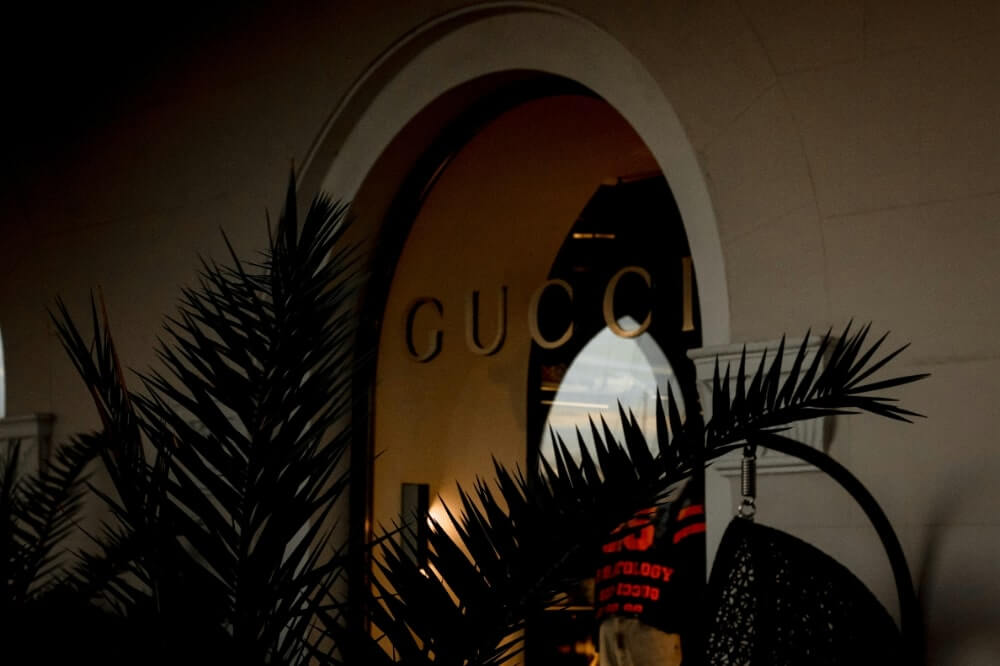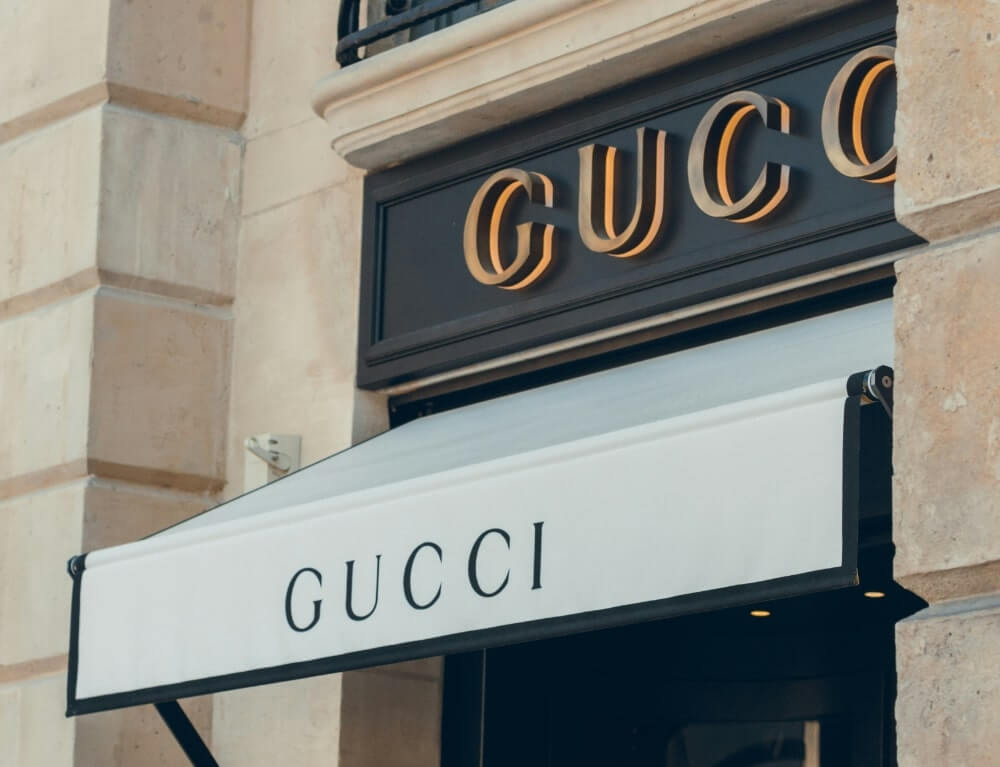Ad

GUCCI items feature tags and designs that vary by era, and understanding these distinctions allows you to gain deeper insight into which period your GUCCI item originates from. This is especially valuable for pieces known as “Vintage GUCCI,” those made before the 1980s, which are admired for their unique design elements and materials that capture the essence of their time. These items remain highly sought after by fashion enthusiasts and collectors alike.
In this article, we’ll provide a comprehensive guide to identifying the era of GUCCI clothing and accessories based on their tags, explore the unique qualities and value of Vintage GUCCI, and offer tips for spotting counterfeits. With these insights, you’ll gain the knowledge needed to fully appreciate and authenticate your vintage GUCCI collection.
What is Vintage GUCCI? Features and Value Explained

Points
・What is Vintage GUCCI? Understanding Its Features and Value
・When Was the Tom Ford Era at GUCCI?
・Key GUCCI Designers and Their Influential Eras
・Is Wearing Vintage GUCCI Outdated?
・How Valuable is Vintage GUCCI?
What is Vintage GUCCI? Understanding Its Features and Value
Vintage GUCCI, often referred to as “Old GUCCI,” encompasses items produced before the 1980s. Particularly during the 1970s and early 1980s, the GUCCI family was closely involved in running the brand, leading to distinctive designs and materials that differ greatly from today’s GUCCI products. These items have gained increased attention recently, especially with the resurgence of the vintage fashion trend.
One key reason for the rising interest in Vintage GUCCI is its unique, retro design, which is quite distinct from current collections. Vintage GUCCI is known for its simplicity and refined elegance, creating a sophisticated, understated look that contrasts with modern styles. Notably, the iconic “Web Stripe” (red and green or blue and red stripe) and the recognizable “GG” logo patterns add an element of sophistication and are highly versatile, making them easy to incorporate into various outfits.
Additionally, Vintage GUCCI pieces are cherished for their rarity, which adds to their allure among collectors and fashion enthusiasts. Given the decades that have passed since their production, well-preserved items are increasingly scarce, driving up their value in the resale market. The rarity of these items has also caught the eye of investors, as their value continues to appreciate over time.
Moreover, many fans of the brand feel drawn to the “heritage” and “tradition” embodied in Vintage GUCCI items, crafted during the era when the GUCCI family was directly involved in production. In 1993, the GUCCI family stepped back from brand management, and GUCCI became part of the Kering Group. Since then, the family has had no role in production, making items from the GUCCI family era particularly special for collectors.
Overall, Vintage GUCCI pieces are valued for their timeless design, rarity, and historical significance, making them beloved items across generations.
When Was the Tom Ford Era at GUCCI?
The Tom Ford era at GUCCI refers to the approximately ten-year period from 1994 to 2004, when designer Tom Ford served as the brand’s Creative Director. During this time, GUCCI transformed from its traditional, classic style to a bolder and sexier aesthetic, capturing global attention and acclaim.
In the early 1990s, GUCCI was facing serious financial challenges, and a new creative direction was essential for the brand’s survival. Tom Ford, then an emerging designer, was appointed as Creative Director and introduced a fresh brand identity defined by “sexy,” “elegant,” and “modern” qualities. Ford’s designs emphasized bold cuts and silhouettes that were both simple and striking, firmly establishing GUCCI as a symbol of “cool, sophisticated luxury.”
Notably, Ford’s 1995 Fall/Winter collection introduced the iconic slip dress, and his 1996 collection featured a velvet suit that became a sensation in the fashion world, securing GUCCI’s popularity and influence. Under Ford’s visionary leadership, GUCCI experienced a dramatic turnaround, reclaiming its place as one of the world’s leading luxury brands.
Thus, the 1994–2004 Tom Ford era represents a pivotal point in GUCCI’s history. Even today, items from this era—known as “Tom Ford GUCCI”—are highly valued and enjoy strong demand in the vintage market, recognized for their distinctive style and enduring appeal.
Key GUCCI Designers and Their Influential Eras

GUCCI has a rich history of showcasing iconic designs crafted by a series of talented designers who defined the brand’s style throughout different eras. Here, we’ll explore GUCCI’s most popular designers and the unique characteristics of each period.
1950s–1960s: The Era of Guccio Gucci and His Family
Founded by Guccio Gucci in 1921 in Florence, GUCCI evolved through the 1950s and 1960s under the leadership of Guccio and his family. This era emphasized classic elegance and high-quality Italian craftsmanship. Key items like the “Bamboo Bag” and the “Web Stripe”—inspired by equestrian gear—were created, establishing the foundation of GUCCI’s brand identity and setting a timeless standard for luxury leather goods.
1980s–Early 1990s: Dawn Mello’s Reformation of GUCCI
Dawn Mello joined GUCCI as CEO in 1989, focusing on restructuring the brand and strengthening its appeal to younger consumers and new markets. Her era prioritized brand rebuilding over design innovation, establishing a stable business foundation that set the stage for future success. Mello’s efforts positioned GUCCI as a luxury brand once again, paving the way for Tom Ford’s impactful arrival.
1994–2004: Tom Ford’s Bold and Sexy Transformation
When Tom Ford became Creative Director in 1994, GUCCI transformed into a brand known for sexy, sophisticated, and modern style. Ford introduced iconic pieces like the silk slip dress and velvet suits, creating a fresh identity for GUCCI. His era, known as the “Tom Ford GUCCI” period, remains highly popular in today’s vintage market, celebrated for its modernity and daring elegance.
2006–2014: Frida Giannini’s Elegant and Romantic Vision
In 2006, Frida Giannini took over as Creative Director, bringing a feminine and elegant touch to GUCCI. Giannini’s designs emphasized Italian tradition while incorporating glamorous and romantic elements, including floral prints and 1970s-inspired pieces. Additionally, she contributed to GUCCI’s charitable efforts, focusing on environmental preservation and women’s empowerment.
2015–2022: Alessandro Michele’s Unique Bohemian Vision
Appointed in 2015, Alessandro Michele introduced a bohemian and eclectic style to GUCCI. Known for his vintage-inspired designs, bold colors, and unconventional silhouettes, Michele created a unique aesthetic that gained worldwide acclaim. His emphasis on gender inclusivity and diversity further shaped GUCCI’s modern identity, making it a brand that celebrates individuality and authenticity.
Through the unique visions of these designers, GUCCI has continuously evolved, establishing a variety of styles and identities that resonate with different generations. Each designer’s distinct influence has created iconic pieces that remain popular with fans and collectors alike.
Is Wearing Vintage GUCCI Outdated?
Old GUCCI, or “Vintage GUCCI,” holds a unique charm as a vintage item and remains popular in today’s fashion scene. However, some people may wonder, “Does wearing Old GUCCI look outdated now?” In truth, Vintage GUCCI can look chic and stylish when styled well, allowing it to feel fresh and current.
Old GUCCI items feature retro designs and silhouettes that differ from GUCCI’s contemporary offerings, giving them a distinctive appeal. Iconic elements like the GG canvas pattern or the “Sherry Line” stripes (red and green or blue and red) set Vintage GUCCI apart from other brands. However, if these vintage features are overemphasized in an outfit, it may look a bit outdated or overly retro.
To make Old GUCCI appear modern and stylish, it’s best to mix these items with contemporary fashion pieces. For instance, pairing a vintage GUCCI bag or belt with simple jeans, a plain T-shirt, or a monochromatic jacket allows the classic GUCCI design to stand out, creating a balanced look. Conversely, combining several vintage elements can make an outfit look overly retro.
Additionally, today’s “retro revival” fashion trend has boosted the popularity of vintage items, including Old GUCCI. Many fashion enthusiasts and influencers incorporate vintage GUCCI pieces into their modern wardrobes, showcasing them on social media. By adding Old GUCCI to an outfit, you can achieve a “timeless yet trendy” look that combines the best of both worlds.
In conclusion, Old GUCCI is far from “outdated” in today’s fashion. Instead, it offers a unique charm that only vintage items can bring. With thoughtful styling, Vintage GUCCI can help create an enduring style that transcends trends, making it a beloved choice across generations.
How Valuable is Vintage GUCCI?
The value of Vintage GUCCI, or “Old GUCCI,” varies greatly depending on factors like item type, condition, and rarity. Some pieces can be found for under $100, but rarer models or those in excellent condition can fetch significantly higher prices.
For instance, items from the “Accessory Collection” and “GUCCI Plus” lines, produced in the 1970s and 1980s, are no longer in production and are highly sought after. Their rarity makes them frequent targets for collectors and high-value sales.
In recent years, Vintage GUCCI’s appeal has grown as people appreciate its unique designs and historical significance, elevating demand among collectors. However, because the value of these items fluctuates with market demand and availability, it’s essential to check for the most up-to-date information if you’re considering a purchase or sale.
How to Identify the Year of GUCCI Clothing by Tag

Points
・How to Identify GUCCI’s Age by Tag Style
・How to Determine GUCCI’s Production Year Using the Serial Number
・How to Identify Fake GUCCI Items
・Summary of This Article
How to Identify GUCCI’s Age by Tag Style
GUCCI products often include tags that provide clues about their production era. The design and engraving style of these tags vary by decade, helping you estimate the manufacturing period of each item.
Starting with GUCCI items from the 1950s to the 1960s, their tags often feature the Gucci family crest, which includes a knight in armor—a symbol of GUCCI’s rich heritage. From the 1960s onward, tags began to incorporate more luxurious gold embossing and leather-embossed stamps, enhancing the vintage look of these items.
In the 1970s, GUCCI’s logo became simpler, and the square “GG” logo made its debut. During this period, tags with serial numbers engraved on leather were established as a standard, allowing for identification through these serials. Additionally, tags began to include engravings on the reverse side, which also served as a countermeasure against counterfeit products.
From the 1980s onward, the cursive “GUCCI” logo was phased out and replaced by a simple stamped logo style. Tags from this period on vintage GUCCI items include a production number, clearly distinguishing them from later releases.
By examining the tag’s engraving style, logo design, and other details, you can identify the approximate production date of a GUCCI item. Tags are a reliable point of reference when determining the authenticity and age of vintage or “old GUCCI” items, offering a valuable guide for enthusiasts and collectors alike.
How to Determine GUCCI’s Production Year Using the Serial Number
GUCCI’s serial numbers are crucial for identifying the production year and verifying the authenticity of items. By understanding the specific characteristics of these serial numbers, you can more accurately estimate the age of a piece and assess its value as a vintage item.
Serial Numbers Introduced in the 1970s
GUCCI started incorporating serial numbers on tags in the 1970s. From the 1980s, a distinct two-line number format was standardized to allow more systematic cataloging. Items without serial numbers on their tags are likely from before the 1970s, as serial numbers were not commonly used until then.
Two-Line Serial Numbers from the 1980s Onward
Since the 1980s, GUCCI serial numbers have been presented in a two-line format. Typically, the upper line represents the model or style number, while the lower line is thought to indicate the production line. This standardized format has become a recognized way to identify vintage GUCCI items and differentiate older GUCCI pieces.
Focus on Number Font and Placement
Authentic GUCCI serial numbers have specific font and placement characteristics. The numbers typically use a font with thick vertical lines and thinner horizontal lines, and they are arranged slightly irregularly rather than perfectly aligned. Notably, numbers like “2,” “3,” and “5” often feature unique curves or “pools” at their ends. This distinctive styling can help in distinguishing authentic pieces from replicas.
Identifying the Year by Searching the Model Number
The upper line, or model number, often remains the same across pieces in the same series or design. You can search this model number online, where it might reveal details about the item’s collection or year. While information for very old models may be sparse, it can still provide useful clues about the production period.
Instances of Missing Serial Numbers
It’s important to note that not all GUCCI items have serial numbers, particularly some vintage collections and special releases. Some older GUCCI pieces do not feature a serial number, so it’s essential not to assume that a lack of one means an item is inauthentic. In these cases, examining the item’s engraving, tag design, and material can provide other insights into its age and authenticity.
Using a magnifying glass to inspect the finer details of the font or unique curves in the serial numbers can also aid in confirming authenticity, making it easier to spot counterfeit pieces.
How to Identify Fake GUCCI Items

Disclaimer: This article does not endorse the purchase of counterfeit items.
Many counterfeit GUCCI items are highly detailed, making it essential to know specific points to identify them accurately. GUCCI items have distinct characteristics in their brand logo, serial numbers, and stitching, which can help you differentiate between authentic and counterfeit pieces.
Start by inspecting the GUCCI logo engraving. Look closely at the shape of letters like “G” and “C”; authentic GUCCI logos have smooth, precise curves, whereas counterfeits often show slight distortions or uneven thickness in the letters. If the font of the logo seems off in any way, proceed with caution.
Next, check the serial number. Genuine GUCCI products always have a serial number, especially on bags and wallets, where it is typically found on the back of the leather tag in a two-line format. Authentic serial numbers are often slightly uneven in their alignment and may have a subtly embossed texture. To verify further, search the serial number online to see if other items with the same number exist.
Another critical area to examine is the stitching and material quality. Authentic GUCCI items feature uniformly tight and straight stitching with no loose threads. Counterfeits, on the other hand, may have uneven stitching, poorly finished thread ends, and less attention to detail. Also, GUCCI’s metal hardware is usually well-plated, while fake items often have thinner, easily worn plating that feels light or cheap.
Inspect the zipper as well. GUCCI uses zippers from reliable manufacturers such as YKK, Lampo, and RiRi. If these marks are missing on the zipper, it may be a fake.
Lastly, check for the control card and dust bag. An authentic GUCCI control card will have a verification number indicating it has been inspected. The dust bag is typically double-stitched and made of high-quality material. Many counterfeit GUCCI items come with single-stitched, lower-quality dust bags, and control cards that lack authenticity.
By assessing these various features together, you can improve your chances of identifying genuine GUCCI products and avoid counterfeit items.
Summary of This Article
In this article, we explained how to identify the production year of GUCCI items by examining tags and serial numbers, as well as the unique qualities and value of Old Gucci pieces. Old Gucci, characterized by traditional designs from the GUCCI family, offers a distinct appeal that sets it apart from current collections. Recognizing specific features—such as tag design, serial number placement, and zipper engravings—can help determine the era of a GUCCI item.
Since many counterfeit GUCCI items are available, paying attention to details like tags, stitching, metal quality, and control cards is essential for authenticating a piece. The quality of the GUCCI logo and serial number engraving is often a major factor that distinguishes genuine items from counterfeits.
If you’re interested in purchasing Old Gucci or other vintage GUCCI items, the information provided here will help you confidently verify authenticity and make a valuable addition to your collection.